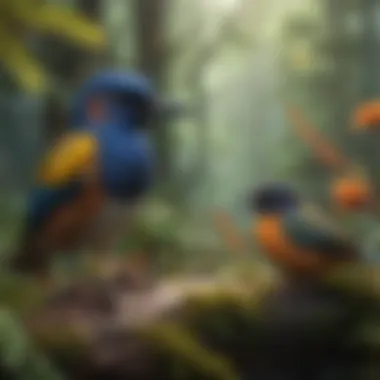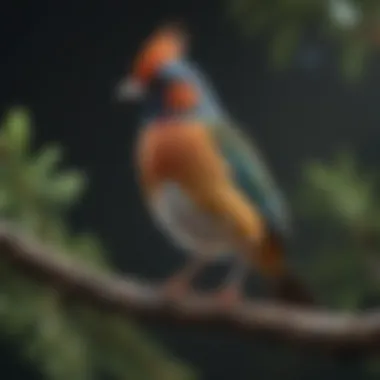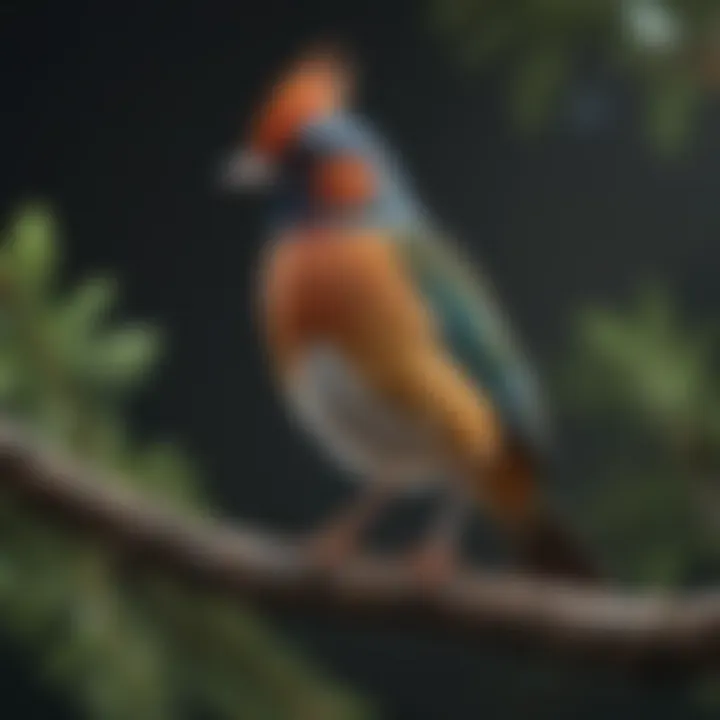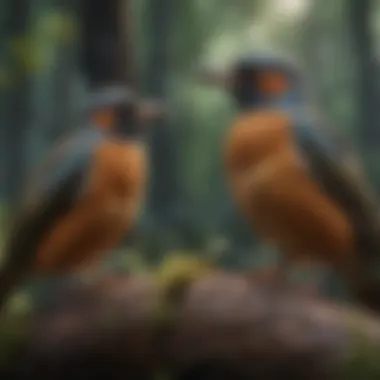Exploring the Wide Range of Bird Species Worldwide


Overview of the Topic
Birds, with their vivid colors and unique songs, play an essential role in our ecosystems. They are not just creatures flying overhead; they are integral components of the natural world, contributing significantly to biodiversity. Delving into the concept of avian diversity reveals a rich tapestry of species that has adapted to a variety of environments across the globe. From the soaring eagles of the high mountains to the delicate hummingbirds flitting around tropical flowers, each bird species brings its own ecological significance.
Understanding this diversity isn't merely an academic exercise; it relates directly to conservation efforts that aim to sustain our planet's health. The interaction between birds and their ecosystems illustrates the interdependence of life. Thus, acknowledging the multitude of bird species and their unique roles enhances our understanding of the environment.
Current Status and Challenges
As we explore the current status of avian diversity, a concerning picture emerges. Many bird species are facing alarming declines in populations, driven by a host of challenges. These range from habitat degradation and climate change to pollution and hunting.
Key factors impacting birds today include:
- Habitat Loss: Urbanization and agricultural expansion cut into habitats, leaving many species in a pinch.
- Climate Change: Altered weather patterns disrupt migration and breeding cycles, putting additional stress on avian populations.
- Pollution: Chemicals in our atmosphere and water systems contribute to declining health in bird populations, affecting their reproduction and survival.
"Birds are the messengers of nature's health; their decline is a harbinger of broader ecological challenges."
Moreover, some species are uniquely vulnerable due to their specialized habitat needs. For instance, the California Condor relies heavily on old-growth forests for nesting. The dwindling number of these habitats leads to a direct threat to their existence.
Sustainable Solutions
Addressing these challenges requires innovative and sustainable solutions. Effective conservation strategies prioritize the restoration of habitats and the creation of protected areas. Some successful practices include:
- Habitat Restoration: Projects aimed at reforesting and rewilding areas can help bring back native bird populations.
- Community Engagement: Local communities play a crucial role in monitoring and preserving bird habitats. Grassroots movements are often the most effective at rallying support for conservation.
- Education Programs: Increasing public awareness about the importance of birds can lead to more grassroots activism and funding for conservation projects.
One effective case study is the Chicago Wilderness initiative, which has successfully brought together various stakeholders to restore natural areas and increase biodiversity. Collaborative efforts have led to significant strides in habitat protection and enhancing avian populations in the region.
Impact and Importance
The impact of bird diversity resonates through ecosystems and communities. Birds contribute to pest control, pollination, and seed dispersal, influencing numerous ecological processes. Their presence often indicates the overall health of an ecosystem, serving as key indicators for environmental changes.
Furthermore, avian populations support local economies through eco-tourism. The chance to observe unique bird species can attract visitors, providing important income for communities.
For more information on various bird species and their significance, visit resources like Britannica, Wikipedia, and discussions on platforms such as Reddit and Facebook.
Intro to Avian Diversity
Understanding avian diversity is akin to stepping into a vibrant tapestry woven with countless threads, each representing a unique species that graces our planet. Birds are not just beautiful creatures that fill the sky; they are vital contributors to the ecosystems they inhabit. This section is designed to explore the immense variety of bird species and their crucial roles within various ecological frameworks. Through an examination of their differences and similarities, we gain insights that can lead to more effective conservation initiatives and heightened appreciation for our feathered friends.
Understanding the Concept of Diversity
Diversity in the avian world can be encapsulated in several dimensions—species diversity, genetic diversity, and ecosystem diversity. Each facet is like a piece of a puzzle, contributing to the greater picture of how birds interact with their environments.
- Species Diversity: This aspect reflects the variety of bird species in different geographical locations. For instance, in tropical rainforests, you may come across dozens of hummingbird species, each with distinct colors and behaviors. In contrast, deserts might only shelter a handful of specialized birds adapted to harsh conditions.
- Genetic Diversity: Consider genetic diversity as the blueprint from which avian adaptation springs. Populations that exhibit genetic variation are better equipped to cope with environmental changes. For example, song sparrows in different regions have evolved unique songs, reflecting their adaptation to local conditions.
- Ecosystem Diversity: Birds inhabit a range of ecosystems—from wetlands to mountains—each supporting networks of life. Forests might host owls, while wetlands provide habitat for herons and waterfowl. This unequaled variety underscores the importance of maintaining diverse ecosystems for the survival of different species.
Appreciating avian diversity means recognizing the interdependence of these layers. A strong population of one species can influence the health of its ecosystem, which in turn affects other species. Through this holistic lens, we can approach conservation efforts with a deeper understanding of the complexities involved.
Importance of Birds in Ecosystems
Birds are not merely observers of the natural world; they play integral roles that affect their environments in profound ways. Their contributions are diverse and essential to ecosystem functioning:
- Pollination: Certain birds, like the hummingbirds, are key pollinators for various flowers. Their intricate interactions with plants facilitate reproduction and genetic diversity among flora, enhancing the resilience of ecosystems.
- Seed Dispersal: Birds such as cedar waxwings consume berries and other fruits, dispersing seeds through their droppings. This process is instrumental in plant propagation. When seeds are dropped far from the parent plant, it reduces competition and contributes to the establishment of new plant populations.
- Pest Control: Birds also act as natural pest controllers. A single owl can consume hundreds of rodents in a season. This behavior helps to maintain the balance of these populations, preventing outbreaks that could harm crops and human interests.
"Birds are indicators of the health of an environment. Their well-being often reflects broader ecological conditions."
- Nutrient Cycling: Through their feeding and excretion behaviors, birds contribute to nutrient cycling within ecosystems. They help sustain soil fertility, create habitats for other organisms, and promote biodiversity.
The wide-ranging benefits provided by birds can hardly be overstated. When we understand the significance of their roles in ecosystems, the urgency of conservation action becomes starkly apparent. Protecting avian diversity not only safeguards the birds themselves but fortifies the holistic health of the habitats they call home.
Classification of Birds
Understanding the classification of birds is crucial in the context of avian diversity. It allows researchers and enthusiasts alike to categorize and study birds based on similarities and differences that stem from their biological characteristics. Each classification sheds light on how species are related, serving as a gateway to understanding their behaviors, habitats, and conservation needs. Moreover, the taxonomic hierarchy lays a foundation upon which ecological studies and conservation strategies can be built, making it a vital element of our exploration into bird diversity.
Taxonomic Hierarchy
The taxonomic hierarchy forms the backbone of avian classification. It arranges birds into several levels, allowing people to comprehend their evolutionary relationships. Starting from the broadest category—kingdom—each subsequent level narrows down the differences among diverse species until reaching specific names at the species level. Commonly, the hierarchy includes:
- Kingdom: Animalia
- Phylum: Chordata
- Class: Aves
- Order, Family, Genus, and ultimately Species.
This structured system does not merely serve academic purposes; it’s also a pragmatic tool for conservationists aiming to develop tailored approaches for preserving various bird species. Knowing how birds relate to one another can influence habitat restoration efforts, policies on hunting, and strategies for protecting endangered species.
Key Orders and Families
Passeriformes: The Songbirds


Focusing on the order Passeriformes, commonly known as songbirds, reveals rich diversity and significance within avian classifications. This order includes the vast majority of bird species, making it a cornerstone of avian fidelity. Their primary characteristic is their vocalization capabilities. This ability plays a significant role in territory establishment and attracting mates, making their songs essential for reproduction.
One of the most appealing features of songbirds is their remarkable adaptability to various environments—from dense forests to urban settings. Their varied diet allows them to thrive in diverse habitats, reflecting resilience in changing ecosystems. This adaptability makes them a beneficial subject for ecological studies as fluctuations in their populations can serve as early indicators of environmental health.
- Unique feature: Vocal Mimicry - Many songbirds possess an extraordinary ability to mimic other sounds, contributing to the richness of their songs.
- Disadvantage: Sensitivity to Habitat Change - Although generally adaptable, songbirds often struggle with rapid urbanization or habitat destruction, making them vulnerable to loss of resources.
Accipitriformes: Birds of Prey
The order Accipitriformes groups birds of prey—an impressive assembly of raptors that include eagles, hawks, and vultures. These birds are distinguished by keen vision and powerful talons, essential traits for hunting. Their role in shaping ecosystems cannot be understated, as they help regulate prey populations, which maintains the balance within their habitats.
What makes Accipitriformes particularly fascinating is their diverse hunting strategies. Some, like the Bald Eagle, soar high above to spot prey from a distance, while others, such as the Red-tailed Hawk, rely on keen hearing and stealth to pounce on unsuspecting animals below.
- Unique feature: Keen Sight - Members of this order have some of the best eyesight in the animal kingdom, enabling them to spot prey from miles away.
- Disadvantage: Threatened by Poisoning - Many raptors face threats from environmental pollutants or poisons, impacting their populations and habitats.
Anseriformes: Waterfowl
Shifting our focus to Anseriformes, which includes ducks, geese, and swans, highlights another critical facet of avian diversity. Their adaptation to aquatic environments allows them to thrive in wetlands, lakes, and rivers worldwide. This order is known for their social behavior, often forming flocks that provide safety in numbers.
Anseriformes exhibit notable migratory behaviors, often traveling vast distances between breeding and wintering grounds. This characteristic not only showcases their resilience but emphasizes the need for conservation of migratory pathways that are crucial for their survival.
- Unique feature: Adapted Feet - Waterfowl typically have webbed feet that allow for efficient swimming and diving, giving them a distinct advantage in aquatic habitats.
- Disadvantage: Vulnerability to Habitat Loss - Since waterfowl are highly dependent on wetlands, the loss of these ecosystems due to farming, urbanization, or climate change poses a significant threat to their survival.
Overall, understanding the classification of birds, and diving deeper into specific orders and families, offers invaluable insights into their ecological roles, adaptations, and conservation needs. As we delve deeper, it becomes clear that each group plays its part in the intricate web of life, reinforcing the importance of preserving avian diversity for future generations.
Habitats of Birds
Birds are exquisitely adapted creatures, thriving in a variety of environments ranging from lush forests to arid deserts. The habitats of birds play a pivotal role in determining not only their survival but also their behavior, adaptations, and interactions with other species. Each habitat provides the necessary resources—food, shelter, and nesting sites—that are vital for their life cycles.
Exploring these habitats reveals how interconnected birds are with their ecosystems. When considering conservation efforts, understanding the intricacies of various habitats becomes crucial, as protecting these environments directly influences bird populations and, by extension, the health of our planet.
Forests: Biodiversity Hotspots
Forests are among the most biodiverse habitats on Earth, serving as crucial nesting and foraging grounds for myriad bird species. Ranging from tropical rainforests, rich with life, to temperate woodlands that change with the seasons, forests form a complex web of interactions. Birds like the Scarlet Macaw and Great Horned Owl are emblematic of the wealth of life these areas support.
In addition to direct benefits, forests provide substantial ecosystem services. They help in carbon sequestration, reducing climate change impacts, and preserving water cycles. Whether perched in the canopy or scavenging in the litter below, birds contribute to seed dispersal and pest regulation. The intricate relationships formed here underscore the importance of preserving forest habitats—lost trees mean lost homes for our feathered neighbors.
Wetlands: Crucial Ecosystems
Wetlands are like nature's sponges, capable of filtering water and mitigating floods. Birds such as the American Avocet and Black-crowned Night Heron find refuge in these environments, with their unique physical and behavioral adaptations tailored to thrive in wetland ecosystems. These areas are breeding grounds for many species, where the shallow waters teem with insects, fish, and crustaceans that serve as food.
Beyond their role in supporting bird populations, wetlands serve as important indicators of environmental health. Their degradation often foreshadows broader ecological challenges, such as pollution or climate change impacts. Preserving wetlands is therefore not just a benefit to birds, but a substantial safeguard for overall ecological integrity.
Grasslands and Savannas
Grasslands and savannas offer a different scene, characterized by open spaces and scattered trees. In these habitats, birds like the Eastern Meadowlark and Secretary Bird have developed unique adaptations to navigate their environments. With vast expanses of grass and the occasional shrub, grasslands provide excellent opportunities for ground-nesting species and foraging.
The critical role that these habitats play in supporting bird life cannot be overstated. They nurture vibrant food webs and crucial ecosystem functions, from soil maintenance to carbon storage. Sadly, grasslands face immense pressure from agriculture and urban development, making their conservation all the more urgent. A world without grassland birds would be a dire loss, echoing the need for conscious efforts to preserve these vital habitats.
Urban Environments
Urban settings are a testament to how adaptable birds can be. With cityscapes and parks replacing traditional habitats, birds like the Rock Pigeon and House Sparrow demonstrate resilience. While urban environments may seem harsh, they can provide essential resources, including food (in the form of waste or food scraps) and nesting sites in buildings and trees.
However, it's a double-edged sword. Cities may offer opportunities, but they also pose threats like pollution and habitat fragmentation. Successful urban planning that takes birds into account is essential, fostering green spaces and bird-friendly buildings. Engaging communities in creating bird-friendly areas not only boosts biodiversity but enhances human connection with nature.
Birds they are everywhere and yet often overlooked. Their presence in urban environments serves as a reminder of nature’s resilience in the face of disruption.
In summary, the habitats of birds present a diverse and complex array of ecosystems. Each environment supports unique species and intricate interdependences that highlight the need for awareness, conservation, and respectful coexistence. Without proactive measures to protect these habitats, we risk diminishing the wealth of avian diversity that enriches our world.
Behavioral Adaptations
Behavioral adaptations are vital to understanding how birds interact with their environments and survive. From finding food to breeding and migration, these strategies are shaped by evolutionary pressures and environmental challenges. For conservationists and environmentalists, recognizing these adaptations is crucial for protecting bird populations and habitats, as changes in behavior often signal shifts in ecology.
Foraging Strategies
Birds use a variety of foraging techniques that demonstrate their adaptability and intelligence. Some species, like the American Crow, exhibit problem-solving skills that allow them to use tools to access food. Others, such as the Hummingbird, have specialized feeding behaviors that enable them to extract nectar from flowers effectively. This specialization helps them thrive in their chosen habitats.
- Visual Foraging: Many birds rely on keen eyesight to spot insects or seeds. Raptors like the Red-tailed Hawk utilize height and sharp vision to hunt from above.
- Benthic Foraging: Waterfowl such as ducks forage on the water's surface or dive for submerged plants and animals, showcasing a unique adaptation to aquatic environments.
- Social Foraging: Certain birds, like the Eurasian Jackdaw, join flocks during foraging, capitalizing on group dynamics to increase success rates in finding food sources.
Each of these strategies not only highlights the diversity of feeding habits but also underscores the connection between a bird's behavior and its ecological niche.
Mating Rituals
When it comes to reproduction, birds display an impressive array of mating rituals that serve as both attraction techniques and social signals. These behaviors are significant for ensuring successful breeding and can vary greatly between species.


Some common rituals include:
- Courtship Displays: Male birds, such as the Peacock, put on elaborate displays of plumage to impress females. They fan their tails and emit calls to demonstrate fitness.
- Duets and Calls: Many songbirds engage in vocalizations that not only establish territory but also attract mates. The operatic calls of the Nightingale are particularly renowned for their complexity.
- Nest Building: The elaborate nests built by certain species, like the Bowerbird, are part of the courting process; males decorate their structures with brightly colored objects to attract females.
These intricate behaviors represent the rich diversity of avian life and are crucial for maintaining population levels.
Migration Patterns
Migration is one of the most remarkable behavioral adaptations seen in birds. Species like the Arctic Tern travel thousands of miles between breeding and wintering grounds, showcasing incredible navigational abilities.
Factors influencing migration include:
- Seasonal Changes: Many birds migrate to exploit resources that vary with the seasons, such as food availability and breeding conditions. The Barn Swallow, for example, migrates to warmer climates when winter arrives.
- Weather Patterns: Birds often time their migrations to coincide with favorable weather, avoiding storms that may hinder their journey.
- Genetic Factors: Some migratory routes are instinctual, indicating that certain species inherit these behaviors, passing down knowledge through generations.
Understanding these migration patterns is crucial for conservation efforts since alterations in climate can impact migratory routes and timings, thereby affecting entire ecosystems.
"Birds are not only a symbol of nature’s beauty but also a testament to the intricate web of life they navigate daily. Their behaviors reveal deep connections to their habitats and ecosystems."
The Role of Birds in Ecosystem Functioning
Birds play a significant role in maintaining the balance of ecosystems. As vital components of their habitats, they contribute to numerous ecological processes. Understanding their functions helps shed light on the interconnectedness of nature and inspires conservation efforts aimed at protecting these remarkable creatures.
Pollination and Seed Dispersal
Birds are not just charming to look at; they are also hard at work behind the scenes, serving as pollinators and seed dispersers. Some bird species, like hummingbirds, feed on nectar, inadvertently transferring pollen from one flower to another. This pollination is crucial for many flowering plants, ensuring their reproduction.
Moreover, seed dispersal is another essential function. Birds consume fruits and seeds—particularly those tasty berries and juicy fruits like mulberries and figs. After satisfying their hunger, they travel significant distances before excreting the seeds, often in a deposits rich with fertilizer. This natural process supports plant diversity, allowing for the establishment of new plants. Consequently, areas that host a wide range of birds often have healthier ecosystems with higher plant diversity.
"Healthy ecosystems are like finely tuned machinery, with each bird playing its unique role in keeping the system running smoothly."
Pest Control
Another critical function that birds fulfill within ecosystems is the control of pests. Birds such as swallows and warblers specialize in consuming insects. Their presence can significantly reduce pest populations that often threaten crops and other plants. For instance, a single swallow can catch thousands of mosquitoes in a day, making them an invaluable ally in pest management.
Birds of prey, including hawks and owls, are significant where rodent populations may explode. By preying on mice, voles, and other small mammals, these birds ensure that these populations remain in check, preventing crop damage and potential disease outbreaks.
In summary, the role of birds in ecosystem functioning is multi-faceted, extending to pollination, seed dispersal, and pest control. Without their contributions, many ecosystems would struggle, highlighting the importance of protecting avian populations and their habitats.
Conservation Challenges
Birds, with their vivid colors and diverse songs, hold a special place in both our ecosystems and human hearts. However, these symbols of beauty face numerous threats that compromise their existence and, by extension, the health of our planet. The challenges surrounding the conservation of birds are not just about preserving species for the sake of aesthetics, but they root deeper, intertwining with broader ecosystem stability and biodiversity. Understanding these challenges enables conservationists, students, and environmentalists alike to advocate effectively for the avian world.
Habitat Loss
One cannot discuss conservation challenges without addressing habitat loss. This issue, arguably the most pressing, occurs for a myriad of reasons including urban development, agriculture expansion, and deforestation. Birds depend on suitable habitats for nesting, foraging, and surviving harsh conditions.
- Urban Development: As cities expand, natural landscapes vanish. Birds that thrive in forests or wetlands find themselves displaced, struggling to adapt to new environments.
- Agricultural Expansion: The push for more farmland converts rich ecosystems into monotonous fields. Many species, especially those that are ground-nesters like the American Woodcock, are significantly impacted.
- Deforestation: Cutting down trees not only destroys nests but also the food sources that birds require. When habitats are fragmented, populations become isolated, which can lead to genetic bottlenecks.
In essence, habitat loss diminishes the essential resources birds need to thrive, creating a chain reaction that affects entire ecosystems.
Climate Change Impact
Climate change presents another significant challenge. As temperatures rise and weather patterns shift, birds are forced to adapt quickly or risk extinction.
- Migration Timing: Many bird species rely on cues from their environment for migration. If climate change causes flowers to bloom earlier, birds may migrate too late to find food.
- Range Shifts: Changes in climate also lead to shifts in suitable habitats. Birds like the Barn Swallow, once prevalent in certain territories, find that their usual breeding grounds are no longer suitable.
- Extreme Weather: Increased frequency of storms and droughts can destroy breeding grounds or food sources in a matter of hours, causing immediate crises for local bird populations.
Ultimately, the ever-changing climate not only threatens bird populations but also disrupts entire ecological networks that depend on avian species.
Invasive Species
Invasive species pose a formidable threat to native bird populations across the globe. These species can outcompete native birds for food and nesting sites, leading to alarming declines in their numbers.
- Predation: Animals like cats and rats, when introduced to new ecosystems, become deadly predators of vulnerable bird species. Ground-nesting birds especially are at high risk.
- Competition for Resources: Invasive plants may dominate local vegetation, altering the habitat in ways that native birds can’t cope with, thus diminishing available food sources.
Fighting back against invasive species is often complex, requiring coordinated efforts to manage both native and non-native populations.
Illegal Trade and Poaching
Lastly, illegal trade and poaching cut deep into avian diversity. Thousands of birds are captured or killed each year for the pet trade or other exploitative purposes.
- Population Declines: Many species, like the Spix's Macaw, have come perilously close to extinction due to overexploitation in the wild.
- Loss of Genetic Diversity: Removing birds from their natural habitats can severely limit genetic diversity, making future populations less resilient to diseases and environmental changes.
This dark trade often operates in the shadows of society, complicating efforts to protect vulnerable birds while raising ethical questions about our relationship with wildlife.


"The greatest threat to our planet is the belief that someone else will save it." – Robert Swan
In diving into conservation challenges, we not only highlight the dire circumstances birds face but also invite a broader audience to take part in the fight for their survival. Addressing these challenges is a battle that extends beyond avian enthusiasts; it is a call to everyone to recognize our shared responsibility for the future of these incredible creatures.
Conservation Efforts
Conservation of birds transcends mere observation; it's a vital aspect of ensuring their survival and the health of our ecosystems. Birds play significant roles in various ecological functions, from pollination to pest control. Thus, safeguarding their populations inspires broader environmental stewardship. With numerous species facing threats from habitat destruction, climate change, and poaching, effective conservation strategies have become increasingly important.
Moreover, engaging with local communities bolsters these initiatives. Conservation efforts help people understand the intrinsic value of birds, leading to a collective responsibility in protecting them. This section unfolds various methods we can use to preserve avian diversity, highlighting the role of protected areas, breeding programs, and education.
Protected Areas and Reserves
Protected areas stand as bastions of biodiversity, offering crucial sanctuaries for bird life. These spaces support various bird species, many of which are vulnerable or endangered. They can include national parks, wildlife reserves, and other designated sites that restrict human activities detrimental to wildlife.
According to the International Union for Conservation of Nature (IUCN), these areas help minimize human interference, allowing ecosystems to thrive.
Some examples of notable protected areas include:
- Yellowstone National Park: A home for diverse species like the trumpeter swan and many raptors
- Pantanal in Brazil: Known for its rich bird life, including the hyacinth macaw and jabiru stork
- Everglades National Park: This region safeguards the endangered American crocodile and supports migratory bird species.
Establishing new reserves and expanding existing ones is crucial. Moreover, effective management of these areas plays a significant role in their success. Surrounding communities should also be involved in protecting these areas to foster a sense of ownership and responsibility.
Breeding Programs
Breeding programs offer hope for many endangered bird species. These initiatives aim to enhance population numbers and genetic diversity. Zoos and conservation organizations often collaborate to maintain genetic viability while also reintroducing birds into their natural habitats. The California condor recovery effort stands as a testament to the effectiveness of these programs, demonstrating that concerted efforts can lead to remarkable recoveries.
The key elements of successful breeding programs include:
- Strategic Pairing: Ensuring genetic diversity can prevent inbreeding, promoting healthier populations
- Habitat Restoration: Before reintroducing species, suitable habitats must be restored to support their survival
- Monitoring: After release, ongoing monitoring ensures that these birds adapt and thrive in their natural environments.
Through these breeding programs, we gain valuable insights on avian biology and ecology, which can inform broader conservation strategies.
Community Engagement and Education
Without community involvement, even the best conservation strategies may falter. Education and engagement programs are pivotal for informing the public about the significance of birds and ecosystems. These initiatives raise awareness of the many challenges birds face, fostering a passionate group of advocates who can drive change.
Effective strategies for community involvement include:
- Workshops and Seminars: These educate local populations about local bird species, migration patterns, and habitat requirements.
- Citizen Science Projects: People can participate in bird counts and habitat monitoring, collecting valuable data for conservationists.
- School Programs: Integrating bird conservation into educational curricula can inspire future generations to take action.
The Future of Birds
Birds, with their vibrant colors and diverse songs, have captivated human beings for centuries. Yet, as we look forward, the future of these remarkable creatures hangs precariously in the balance. Understanding the potential trajectory of avian populations is crucial, not just for ornithologists, but for anyone who values the intricate web of life on our planet. The interplay between ongoing research and public engagement plays a pivotal role in shaping a sustainable future for birds.
Ongoing Research and Findings
Research in avian biology is continually evolving, revealing the complexities of bird behavior, habitats, and the environmental factors that influence their survival. Recent studies have shed light on various intriguing aspects:
- Habitat Preferences: Scientists have begun to map how different species prefer specific environments, leading to better habitat management practices.
- Adaptation Mechanisms: Ongoing observations show how birds are adapting their behaviors in response to climate change; this includes shifts in migration times and breeding patterns.
- Genetic Diversity: Advances in genetic research contribute insights into how genetic diversity within bird populations can affect their resilience to environmental changes.
Innovations like satellite tracking systems allow researchers to monitor migration patterns in real time, providing unprecedented data on how species respond to climate fluctuations. These findings are not just academic; they have real-world implications for conservation strategies and can influence policy decisions.
Encouraging Citizen Science
The role of the general public in bird conservation cannot be understated. Citizen science initiatives harness the enthusiasm of amateur bird watchers and contribute significantly to avian research. Here are notable aspects of citizen science in bird conservation:
- Data Collection: Laypersons can help gather essential data on bird populations through organized efforts like the Audubon Society’s Christmas Bird Count. This involves countless volunteers tracking birds in their local areas, aiding in population assessments across the globe.
- Community Engagement: Local events promote awareness and education, bringing people into direct contact with their avian neighbors, helping foster appreciation and urgency for conservation.
- Empowerment of Individuals: Participation in citizen science allows individuals from all backgrounds to contribute meaningfully to the conservation cause, reinforcing the idea that anyone can make a difference.
"No matter how small, every bit counts. Each sighting, each note shared can create ripples in our understanding of avian life."
Ending
As we draw the curtains on this exploration of avian diversity, it becomes evident that birds are not mere ornaments of our environment; they are integral players in the ecosystems they inhabit. Their myriad forms, colors, and behaviors tell a compelling story of adaptation and survival. From the light-hearted chirps of a sparrow to the majestic flight of an eagle, the importance of birds stretches far beyond aesthetic value; they serve crucial roles in maintaining ecological balance.
Summarizing the Importance of Avian Diversity
Birds contribute to various essential ecosystem functions. They act as pollinators, dispersers of seeds, and manage pest populations. For instance, hummingbirds are known to pollinate flowers while feeding on nectar. Similarly, raptors like the Bald Eagle keep rodent populations in check, which helps maintain the integrity of their habitats. Beyond functional roles, the diversity of birds can be seen as a reflection of wider environmental health. Each species thrives in specific habitats and is sensitive to changes in their environment. This intricate connection means that conserving bird species often leads to greater overall ecosystem health.
The importance of avian diversity goes beyond the natural world. For the people who study them—ornithologists, conservationists, and everyday bird watchers—these creatures also serve as a touchstone for understanding biodiversity at large. They are indicators of environmental changes, thus providing critical clues to the state of the ecosystems we rely on.
Call for Continued Advocacy and Action
Despite their significance, avian populations are facing unprecedented threats—from habitat loss to climate change and illegal trade. Such issues underscore the necessity for sustained advocacy and action. Society as a whole must pull together to address these challenges. Implementing protective policies, expanding protected areas, and promoting sustainable practices can make a tangible difference in the plight of these birds.
To encapsulate the key points:
- Advocacy is required at all levels, from local communities to international platforms.
- Education and outreach are bombarding, ensuring more people understand the roles birds play in our ecosystems.
- Citizen science initiatives can empower ordinary people to contribute to the knowledge and protection of avian diversity.
In the end, it’s not just about saving the birds; it’s about leading towards a healthier planet. By continuing to advocate for and support avian diversity, we cultivate not only thriving bird populations but also robust ecosystems and, ultimately, a healthier world for all living beings.



